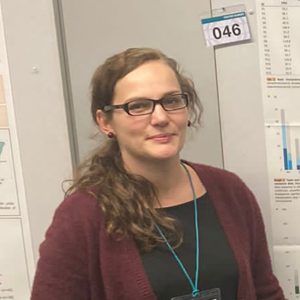Best poster prizes at EMBL Conference ‘Cancer genomics’
A few weeks ago, the EMBL Conference ‘Cancer genomics’ brought scientists from diverse disciplines connected to cancer research, creating a unique opportunity for interaction and fostering greater integration of these collaborative efforts. The event was nothing short of amazing, with vibrant discussions, valuable connections, and stimulating presentations. To add to the excitement, we are proud to announce the winners of the best poster prizes, recognizing outstanding contributions to the field. Without further ado, let’s shine a spotlight on the remarkable winners! Take a moment to explore their outstanding contributions — your dose of inspiration awaits.
MHC class II genotypes are independent predictors of anti-PD1 immunotherapy response in melanoma
Presenter: Arne Claeys

Abstract: Immune checkpoint blockade is a highly successful anti-cancer immunotherapy. Both CTLA4 and PD1 checkpoint blockers are clinically available for melanoma treatment, with anti-PD1 therapy reaching response rates of 35-40%. These responses, which are mediated via neoantigen presentation by the polymorphic MHC complex, are hard to predict and the tumor mutation burden (TMB) is currently the best available biomarker. While responses are expected to be strongly determined by the MHC genotype, single allele association studies have remained elusive, likely due to the low population allele frequency and resulting lack of statistical power. To solve this problem, we quantified the complete MHC genotype based on the functional MHC binding properties and demonstrate that the MHC class I (MHC-I) and class II (MHC-II) genotypes are TMB-independent predictors of anti-PD1 immunotherapy responses in melanoma. Opposite responses were found for both classes, with strong MHC-I and MHC-II binding genotypes predicting good and bad responses, respectively. Interestingly, MHC-II binding genotypes were mainly associated with treatment response failure in a subgroup of anti-CTLA4 pretreated patients. As MHC genotyping does not require tumor material and/or advanced sequencing, it has clinical potential as a non-invasive and tumor-independent biomarker to guide anti-cancer immunotherapy in melanoma.
Stepwise transcriptional progression of myeloid leukaemia associated with Down syndrome
Presenter: Mi Trinh

Abstract: Down syndrome (DS) is a genetic condition caused by the presence of an extra copy of chromosome 21 (trisomy 21 or T21). Children born with DS have a substantially higher risk of developing childhood leukaemia. Approximately 30% of DS infants develop a preleukemic condition called transient abnormal myelopoiesis (TAM). TAM is strictly associated with GATA1 truncating mutations in a T21 background. Peculiarly, most TAM cases spontaneously resolve within the first few months of life. However, by the age of five, approximately 20% of cases progress to megakaryoblastic/erythroid leukaemia, known as myeloid leukaemia associated with DS (MLDS). Current literature suggests that T21 causes perturbed myelopoiesis within the developing foetal liver, and the GATA1 mutation then further predisposes the individual to leukaemogenesis (TAM). We aim to further characterise the mechanism underlying this multi-step development of leukaemogenesis in DS: from diploid to T21, to the acquisition of GATA1 mutations in TAM, and finally, acquisition of additional transforming mutations in MLDS. Here, we directly interrogate these transcriptional changes at single-cell resolution, using primary human samples. We generated whole genome and single-cell RNA sequencing data from T21 human foetal livers, and bone marrow aspirates or peripheral blood from children with MLDS or TAM. We showed that T21 haematopoietic stem cells are enriched for the transcriptional programme of megakaryocyte-erythrocyte progenitors (MEPs), which may underpin the expansion of MEPs observed in T21 foetal liver. TAM/MLDS blast cells generally resemble MEPs transcriptome, but also show heterogeneous signatures of differentiation towards erythrocytes, megakaryocytes, and mast cells. The degree of differentiation was then assessed for potential correlation with clinical features. Ongoing work is focused on defining the transcriptional consequences of GATA1 mutation in the context of T21, and molecular signatures of refractory MLDS. Overall, our results provide in-depth mechanistic insights into the transcriptional consequences of T21 in early haematopoiesis and the stepwise progression of TAM and MLDS, offering the possibility of more meaningful clinical interpretations and new therapeutic targets for these conditions.
Poster not available due to unpublished data.
Application of long-read sequencing in chronic lymphocytic leukemia cases with complex karyotype
Presenter: Kamila Stránská

Abstract: Introduction: Complex karyotype (CK) typically involves various, often extensive numerical and structural chromosomal abnormalities. In chronic lymphocytic leukemia (CLL), it represents an established adverse prognostic marker. Common methods to detect CK include classical cytogenetics and genomic microarray, however, their resolution is limited. We aimed to explore the ability of long-read sequencing for the precise characterization of complex genomic variants in CLL patient samples. Methods: CK cases were identified and characterized using classical (IL-2/CpG-stimulated chromosomal banding) and molecular (24×Cyte Multicolor FISH, CytoScan HD Array) cytogenomics. For long-read sequencing, high molecular weight DNA was isolated using chloroform isopropanol extraction, fragmented by needle shearing, and short DNA fragments were eliminated. The sequencing libraries were prepared using the Ligation Sequencing Kit (Oxford Nanopore Technologies) and sequenced on the MinION or PromethION platform. Reads were aligned to the hg38 human genome reference, and breakpoints were identified with the SVIM variant caller. Results: For 21 patients, we obtained sequencing data providing 10× (MinION; 4 patients), or >20× (PromethION; 17 patients) average coverage of the genome, with N50 15–25 kb. Identified breakpoints were compared with available cytogenomic results of classical karyotyping, mFISH and genomic microarray. The majority of these results were confirmed by long-read sequencing. In addition, we observed breakpoints in both CLL-associated genes and non-recurring genes affecting cell signaling pathways, which may impact biological processes in CLL cells. Discussion & conclusion: Our study contributes to a better understanding of the structural variants present in complex CLL genomes and their impact on the leukemic cell phenotype. By confirming previously detected breakpoints using long-read sequencing, we demonstrated the reliability of this approach in characterizing selected chromosomal rearrangements. However, challenges remain in identifying breakpoints in highly repetitive regions. To address this, we intend to employ the T2T human reference.
Poster not available due to unpublished data.
A pan-cancer copy number profile database from published array-based studies
Presenter: Ioana-Antonia Vlaicu

Abstract: Copy Number Aberrations (CNAs) accumulate throughout tumor development and are linked to prognosis. CNAs can amplify oncogenes or delete tumor suppressor genes, but even simple gains or losses have large-scale effects on the transcriptomes through gene-dosage effects. Thus, they are important to consider when studying cancer genomes and the reprogramming of the metabolic pathways of cancer cells. To date, the data of hundreds of studies using microarrays on cancer patients have been published, and the genomic data resulting from these studies is publicly available on databases such as Gene Expression Omnibus and ArrayExpress. These valuable resources can thus be used to infer the copy number profiles of thousands of cancer patients and provide an easy way to access them in the form of a database. Using state-of-the-art tools and novel pipelines, we constructed a database of curated copy number profiles from this published cancer array data, and compiled them in an accessible web application. To cover a large majority of high-resolution genome-wide studies, we ran ASCAT and ASCAT.sc to infer the copy number profiles from Affymetrix SNP arrays and Illumina methylation arrays, respectively. Two automated pipelines were implemented to derive copy-number profiles in batches without the need for manual intervention. In particular, patient sex was inferred and ASCAT was run in tumor-only mode, avoiding the need to manually match tumor and normal samples. Our web application allows the retrieval and inspection of an extensive resource of cancer related copy number profiles. Users have access to the generated CNPs, along with additional illustrative and explorative figures. This aims to allow any member of the scientific community to quickly explore the landscape of CNAs across cancer types, and also to model their prevalence for understanding their role in cancer progression, to potentially identify signatures of mutational processes and markers for clinical diagnosis and prognosis, as well as aid the identification of driver genomic regions.
T cell receptor diversity and blood T cell fraction is associated with outcome in bladder cancer
Presenter: Asbjørn Kjær

Abstract and poster not available due to unpublished data.
The EMBL Conference ‘Cancer genomics’ took place from 15 – 17 November 2023 at EMBL Heidelberg and virtually.